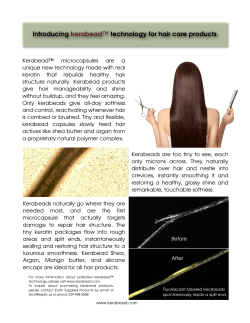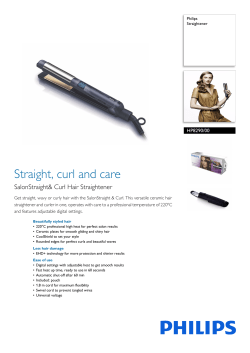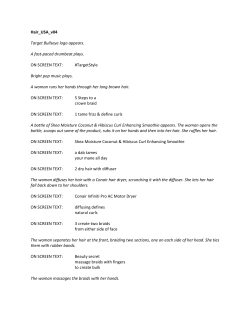
The Integumentary System Guaranteed to Last a Lifetime Chapter 5
The Integumentary System Guaranteed to Last a Lifetime Chapter 5 Integumentary System Integument (skin) and Accessory Organs • Cutaneous Membrane (Skin) – largest organ - epidermis - dermis • Accessory Organs – derive from epithelial cells of the epidermis but all extend into the dermis - sweat glands and sebaceous (oil) glands - hair follicles - nails • Hypodermis – has similar functions as skin - fatty layer deep to the skin - connects skin to underlying organs Skin Structure Figure 5.1 Skin and Underlying Tissues • ~7% of total body weight • 1.5 – 4 mm thick • 2 distinct regions: - epidermis, superficial thick epithelial tissue - dermis, fibrous CT deep to the epidermis • Deep to the skin is the hypodermis - composed of loose areolar CT and adipose tissue Figure 5.2 Functions of The Skin Helps the body to maintain homeostasis • Protection against environmental hazards • Thermoregulation • Synthesis and storage of lipid reserves • Synthesis of vitamin D • Excretion (urea, salts, water) • Sensory information • Coordination of immune response LE 4-1 • Physical protection from environmental hazards • Thermoregulation • Synthesis and storage of lipid reserves • Protects dermis from trauma, chemicals • Controls skin permeability, prevents water loss • Prevents entry of pathogens • Synthesizes vitamin D3 • Sensory receptors detect touch, pressure, pain, and temperature • Coordinates immune response to pathogens and skin cancers • Excretion • Synthesis of vitamin D3 • Sensory information • Coordination of immune response to pathogens and cancers in skin PAPILLARY LAYER RETICULAR LAYER • Nourishes and supports epidermis • Restricts spread of pathogens penetrating epidermis • Stores lipid reserves • Attaches skin to deeper tissues • Sensory receptors detect touch, pressure, pain, vibration, and temperature • Vessels assist in thermoregulation • Produce hairs that protect skull • Produces hairs that provide delicate touch sensations on general body surface • Assist in thermoregulation • Excrete wastes • Lubricate epidermis • Protect and support tips of fingers and toes Epidermis • Consists of keratinized stratified squamous epithelium • 4 distinct cell types: keratinocytes, melanocytes, Merkel cells, and Langerhans cells • Layers of the Epidermis (from superficial to deep): - Stratum corneum - Stratum lucidum (only in thick skin) - Stratum granulosum - Stratum spinosum - Stratum basale Layers of the Epidermis Figure 5.3 Thick vs Thin Skin 5 layers vs 4 layers or strata (‘bed sheets’) - covers palms and soles Fig 5.4 - covers rest of the body Epidermal Cells • Keratinocytes – produce keratin, a tough fibrous protein - provides physical and mechanical protection - produces antibiotics and enzymes that detoxify harmful chemicals - undergoes almost continuous mitosis • Melanocytes – produce the skin pigment melanin (‘black’) - made in granules and transferred to nearby keratinocytes - cluster on the superficial side of keratinocytes (between incoming radiation and cell nuclei) shielding the cell’s DNA from UV rays - digested by lysosomes in light-skinned people - secretes signaling moleules in response to UV radiation that act to modulate the skin’s immune and inflammatory responses • Merkel cells – hemisphere-shaped cells sensitive to touch - when compressed release chemicals that stimulate disclike sensory nerve endings (touch receptor) • Langerhans cells – star-shaped dendritic type cells - take up pathogens by receptor-mediated endocytosis - travel to a nearby lymph node to initiate an antigenic immune response Stratum Basale (Basal Layer) Aka the stratum germinativum (‘germinating layer’) - the deepest epidermal layer firmly attached to the underlying dermis • Consists of a single row of cells mostly young keratinocytes (stem cells) - as these cells are pushed up by production of new cells beneath them they make the keratin that eventually fills their cytoplasm - when they reach the skin surface they are dead, flat sacs of keratin • Merkel cells are distributed sparsely among the keratinocytes - associate with disclike sensory nerve ending • 10-25% of the cells are spider-shaped melanocytes (‘melanin cells’) Stratum Spinosum (Spiny Layer) Name is derived from spinelike extensions of its keratinocytes (artifact created during tissue preparation) • Several cell layers thick • Lower rate of mitosis than in the basal layer • Contain thick bundles of intermediate filaments - tonofilaments (‘tension filaments’) that contain pre-keratin (tensionresisting protein) • Langerhans cells - scattered among the keratinocytes - initiate an immune response to all foreign cells that carry a foreign antigen (lymphocyte activation) Stratum Granulosum (Granular Layer) Thin layer with many granules • Composed of 1 to 5 layers of flattened keratinocytes • Contain abundant tonofilaments • Contain granules - keratohyalin and lamellated (plated) - keratohyalin granules help form keratin in the more superficial layers - lamellated granules contain a waterproof glycolipid that is secreted into the extracellular space (slows water loss across the epidermis) • PM of the cells thicken to become more resistant *Epidermal cells in the layers above the stratum granulosum, are too far from the dermal (underlying CT) capillaries to receive nourishment Stratum Lucidum (Clear Layer) Aka the transition zone • Occurs only in thick skin • In light microscopy appears as a thin translucent band • Consists of a few rows of flat, dead keratinocytes - electron microscopy reveals these cells are identical to the next layer Stratum Corneum (Horny Layer) Most external (superficial) layer of the epidermis • Many cells thick and much thicker than in thin skin • Dead keratinocytes are completely filled with keratin - upon death their nuclei and organelles disintegrated • Keratin consists of tonofilaments embedded in a ‘glue’ from the keratohyalin granules - both the keratin and the cells’ thickened PMs protect skin against abrasion and penetration • Waterproof layer due to the glycolipid between the cells • Cells are referred to as cornified or horny (cornu = horn) - they are the dandruff shed from the scalp and flakes from dry skin - an average person sheds ~18 kg (40 lbs) in a lifetime (a) (b) The Dermis The 2nd major layer of the skin is a strong flexible CT that binds the entire body together • Consists of 2 layers: the papillary and reticular layers • Cell types: fibroblast, macrophages, mast cells, and scattered WBCs • Fiber types: collagen, elastic, and reticular • Richly supplied with nerve fibers and BVs Dermal BVs 2 vascular plexuses -network of converging & diverging vessels • Deeper cutaneous plexus (between hypodermis and dermis) - nourishes the hypodermis and the structures within the deeper portions of the dermis • More superficial subpapillary plexus (below dermal papillae) - supplies more superficial dermal structures, the dermal papillae and the epidermis • Dermal BVs play a critical role in thermoregulation - BVs are extensive and can hold 5% of all blood in the body - if internal organs need more blood or heat, nerves stimulate dermal vessels to constrict shunting more blood into the general circulation - on hot days dermal vessels engorge with warm blood, cooling the body by radiating heat away from it Papillary Dermal Layer Papillary layer – superficial 20% of the dermis • Composed of areolar CT with thin collagen & elastic fibers • Papillae (‘nipples’), fingerlike projections that extend into the overlying epidermis - increases surface area for exchange of gases, nutrients, and waste products between the dermal layers - avascular epidermis depends on the diffusion of these materials - interdigitation strengthens the dermal-epidermal junction reducing blister formation • Contains dermal ridges – papillae lie atop of these mounds - elevates overlying epidermis into epidermal ridges (friction ridges) create fingerprints, palmprints, and footprints - increases friction, enhances gripping ability of the hands and feet - patterns are unique and genetically determined - sweat pores, open along crests of epidermal ridges leave distinct fingerprints Reticular Dermal Layer Deeper reticulum (network) layer accounts for ~80% of the dermis thickness • Consists of dense irregular CT • ECM has thick bundles of interlaced collagen & elastic fibers - named for its networks of collagen fibers • Lines of cleavage or tension lines - separation formed by less dense regions between collagen bundles - invisible lines occur over the entire body important that surgeons make incisions parallel to these lines • Collagen fibers give skin its strenth and resilience • Elastic fibers provide stretch-recoil properties - extreme stretching results in striae (‘streaks’) • Flexure lines, markings from the deep part of the dermis Flexure lines form as a result of a continual folding of the skin, often over joints, where the dermis attaches tightly to underlying structures (palm, wrist, soles, fingers, and toes) Figure 5.5 Hypodermis (‘below the skin’) Fatty hypodermis deep to the skin aka the superficial fascia = subcutaneous (‘below the skin’) layer • Consists of both areolar and adipose CT • Stores fat • Anchors skin to underlying structures (mostly muscle) - but allows skin to slide relatively freely • Insulator – fat a poor conductor of heat prevents heat loss from the body • Thickens with weight gain - accumulates 1st in the thighs and breasts of ♀s - in ♂s accumulates in the anterior abdomen (beer belly) Skin Color 3 pigments – melanin, carotene, hemoglobin • Melanin, most important - tyrosine (tyrosinase) - ranges from yellow to reddish to brown to black • Carotene, yellow-orange pigment - vegetables - accumulates in the epidermis stratum corneum and in the fat of the hypodermis • Pink hue - oxygenated hemoglobin - from capillaries of the dermis - Caucasian skin contains little melanin allows color of blood to show - bruising reflects sites where blood escaped from the circulation and clotted below the skin • Hematoma (‘blood swelling’), clotted mass of escaped blood Abnormal Skin Colors • Cyanosis – bluish color • Erythremia – abnormal redness • Jaundice – yellowish color • Pallor – pale or ashen color • Albinism – pale skin, white hair, pink eyes • Hematoma – black & blue bruise Nails • Superficial keratinized layers of the epidermis • Has a distal free edge, a body, and a root; rests on a epidermal nail bed (‘little moon’) (‘on the nail’) • Pink color due to rich network of capillaries in the underlying dermis Figure 5.6 Hair Distributed all over the skin surface, except on palms, soles, nipples, and parts of external genitalia • Main function - to sense touch • Thermoregulation - scalp hair protects the head against direct sunlight on hot days and heat loss on cold days • Consists of a flexible strand of dead, keratinized cells - hard keratin predominates in hair and nails: 1) tougher and more durable 2) cells do not flake off • Chief parts – the root (embedded in the skin) and the shaft (projects above the skin surface) Hair Structure A hair shaft consists of 3 concentric layers: Medulla (‘middle’) central core of large cells and air sacs Cortex consists of several layers of flattened cells Cuticle a single layer of overlapping cells - most heavily keratinized provides strength and binding Figure 5.7 Hair Follicles Extend from the epidermal surface into the dermis • Hair bulb – expanded end of the follicle • Hair follicle receptor or root hair plexus – knot of sensory nerve endings • CT papilla (hair papilla) – dermal bit that protudes into the hair bulb contains a knot of capillaries • Hair matrix – epithelial cells in the hair bulb - proliferating cells that form the hair shaft • Wall of a hair follicle is composed of: - an outer CT root sheath (derived from the dermis) - inner epithelial root sheath (derived from the epidermis) • Glassy membrane – basement membrane of the follicle epithelium Arrector pili (‘raiser of the hair’) muscle • Bundle of smooth muscle cells associated with each follicle Figure 5.7 Figure 5.8 Scanning electron micrograph of a hair shaft emerging from a follicle at the epidermal surface Types and Growth of Hair • Vellus (vell=wool,fleece): body hair, fine and short • Terminal: longer coarser scalp hair and hair that appears at puberty • Androgens (testosterone): male sex hormone that influences terminal hair (face, chest, arms, and legs) •Active follicle •Resting follicle Figure 5.9 Sebaceous (‘greasy’) Glands The skin’s oil glands • Occur over entire body except palms and soles • Simple alveolar glands with several alveoli openings into a single duct - alveoli filled with cells (no lumen) that produce sebum (‘animal fat’) • Holocrine secretion (holos = whole) - central cells fill with oily lipids until they burst - empty sebum into the upper 1/3 of hair follicles - spread superficially to cover the skin - secretion stimulated by hormones, especially androgens • Makes skin and hair oily and in addition: - collects dirt, softens and lubricates hair and skin, prevents hair from becoming brittle, keeps epidermis from cracking - helps to slow water loss across the skin and kills bacteria Sebaceous Glands Figure 5.10 Sweat (sudoriferous) Glands Only mammals have sweat glands • humans have > 2.5 million over entire skin surface - produce about 500 ml of sweat per day (up to 12L) • Sweat - 1° a blood filtrate released by exocytosis - 99% water + some salts (NaCl) and traces of metabolic wastes (urea, ammonia, uric acid) - acidic property retards growth of bacteria • 2 types of sweat glands – eccrine (‘secreting’) & aprocrine - both secrete in response to heat or stress - eccrine glands are more numerous and produce true sweat - aprocrine glands are mainly confined to the axillary, anal, and genital areas and produce viscous and sometimes a milky or yellow color secretion Sweat Glands Eccrine glands - most abundant on palms, soles, and forehead - coiled, secretory base in the deep dermis and hypodermis - duct opens at skin surface (pore) Note: facial pores are openings of hair follicles Apocrine glands - function at puberty due to androgens - ducts open into hair follicles - involved in sexual signaling (pheromones) Figure 5.10b Burns Tissue damage inflicted by heat, electricity, radiation, extreme friction, or chemical • Immediate threat from serious burns – loss of body fluids - severe inflammatory edema - dehydration leads to circulatory shock • Followed by infection – loss of skin barrier • Classified by severity (depth): partial and full-thickness - 1st degree = only epidermis is damaged (sunburn) - 2nd degree = epidermis and upper part of the dermis (blisters) - 3rd degree = epidermis, dermis, hypodermis • Rule of Nines - divides the body into 11 regions - Critical burns: 1) over 10% of the body has 3rd degree burns; 2) 25% of the body has 2nd degree burns; 3) 3rd degree burns on the face, hands, or feet Burns – Rule of Nines Figure 5.11 Skin Cancer Most common type of cancer, ~million new cases in US / year • Highest risk factor – overexposure to UV rays in sunlight • Increased risk with use of indoor tanning • 3 types of skin cancer: - Basal Cell Carcinoma - Squamous Cell Carcinoma - Melanoma Basal Cell Carcinoma • • • • • • Least malignant; most common (>30% of all Caucasians) Cells of stratum basale proliferate, invading the dermis & hypodermis Most common lesions are domeshaped, shiny nodules on the face Nodules develop an ulcer Grows slowly, metastasis is rare 99% full cure by removal Squamous Cell Carcinoma • • • • • Arises from the keratinocytes of the stratum spinosum Scaly, irregular, reddened papule that grows rapidly Metastasis - if not removed Overall cure rate 99% Treatment - radiation, surgery, skin creams with anticancer drugs Figure 5.12 Most Dangerous Melanoma Cancer of Melanocytes Only 1 of every 20 skin cancers • Increasing by 3-8% / yr in US • Often arises from existing moles • Melanoma cells metastasize - into surrounding circulatory vessels • Key to survival early detection - low survival chance mole >4mm thick • Resistant to chemotherapy and immunotherapy • ABCD(E) rule Asymmetry – 2 halves don’t match Border irregularity – indents / notches Color – pigment spot, several colors Diameter - >6mm Elevation – above the skin surface The Skin Throughout Life • • • • • • • • Epidermis develops from embryonic ectoderm Dermis and hypodermis develop from mesoderm Melanocytes develop from neural crest cells (3 months) In 5th and 6th months fetus covered with lanugo (‘wool/down’) Shed by the 7th month when vellus hairs appear Birth skin covered with vernix caseosa (‘varnish of cheese’) Adolescence, acne may appear, subsides in early adulthood Optimal appearance in 20’s – 30’s - after skin shows harmful effects of continued environmental assaults - dermatitis become more common • Photoaging - pigment spots ‘liver spots’ - large amounts of melanin protect skin from photoaging Clinical Terms • Alopecia • Athlete’s Foot • Boils and Carbuncles • Cold Sores (Fever Blisters) • Impetigo (‘an attack’) • Psoriasis (‘an itching’) • Vitiligo (‘blemish’)
© Copyright 2025













